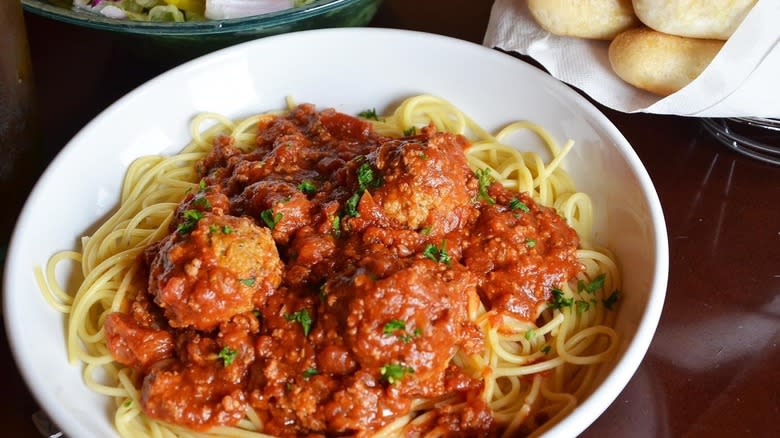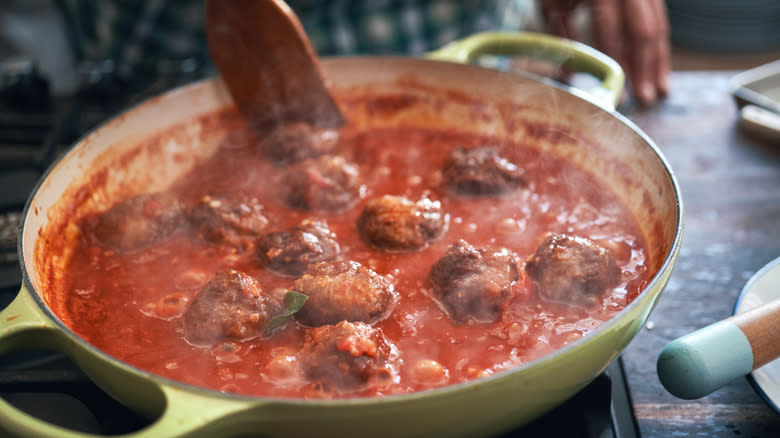The Olive Garden Meatball Mistake You Wouldn't Catch Real Italians Making

When you're craving buttery breadsticks, a hot bowl of soup, and seemingly never-ending pasta options, Olive Garden can be a great dinner option. With over 900 locations in the United States, the carpeted floors and vine-covered exteriors have become synonymous with Italian-American food. However, many Italians and lovers of Italian cuisine will turn their noses up at the popular restaurant chain, claiming that the pasta spot can hardly call its menu items genuine.
Olive Garden is known for breaking quite a few rules of Italian food, from the "Italian" dressing on its salads that wouldn't be found anywhere in Europe to the brand's plate of spaghetti topped with a mountain of meatballs. In fact, the size of Olive Garden's meatballs, in particular, is a giveaway that the restaurant doesn't serve faithfully traditional Italian cuisine. Ironically, the robust meatiness of the meatballs is a clear indication of just how American the brand really is. If you're looking for classic meatballs at an Italian restaurant, check the appetizer or small plate section to see if the kitchen offers a small, individually plated version sans pasta.
Read more: The Ultimate American Fast Food Restaurants Ranked
Classic Italian Meatballs Look Very Different

Traditional Italian meatballs are much smaller than those at Americanized Italian restaurants like Olive Garden. They are generally served as an appetizer or side dish on a separate plate from any main course pasta dishes. You can also find them in soups like Italian wedding soup or a casserole-like dish called Polpette Al Sugo. What you will not find in old-world Italian cuisine is a plate of spaghetti and meatballs drenched in sauce. It is widely understood that spotting spaghetti and meatballs on a menu is a sign that the restaurant is not stringently Italian. You likely won't see spaghetti and meatballs on menus in Italy unless the restaurant caters to people looking for a recognizable dish while traveling far from the States.
A note to "Lady and the Tramp" fans: This romantic dish is actually American-made. The first known recipes for spaghetti and meatballs were created by Italian immigrants who came to America during the late 19th century as a way to delight in the plethora of ingredients they now had at their disposal. While it may not be considered conventionally American, many Italians and Italian-Americans likely enjoy a plate of spaghetti and meatballs every now and then, though they probably wouldn't want to be caught enjoying it in Italy.
Is Anything About Olive Garden Considered Traditional?

While the restaurant offers menu items like the "Tour of Italy" featuring a slice of lasagna, chicken parmesan, and a scoop of fettuccine Alfredo, that is about where Olive Garden's connection to Italy ends. While there is no one specific definition of what is considered genuine Italian food, it is much easier to identify what is not, including massive portions of dishes covered in cheese, sauce, and butter -- practically everything on Olive Garden's menu.
While the restaurant has made attempts at classically Italian meals in the past, the chain has never claimed to serve traditional Italian food. Olive Garden's offerings hew closely to Italian-American culinary traditions, as well as Americanized versions of recognizable dishes served in Italy (like pasta carbonara), which works for its customer base. Many lovers of the endless soup, salad, and breadsticks will argue that Olive Garden isn't harming anyone by offering dishes with more cheese and cream than you'd likely see served in Italy. In a discussion of Olive Garden's authenticity, some Reddit users pointed out that the brand caters to many people who appreciate its fancy feeling at a reasonable price point, allowing middle-class families to enjoy a taste of Italian cuisine without breaking the bank. Whether you're in the mood for a garlicky breadstick or you want to enjoy an extra large meatball atop a mountain of spaghetti, Olive Garden isn't here to judge.
Read the original article on Daily Meal.

